At Viral Launch, we thrive on understanding and discovering the intricacies and science of the Amazon marketplace. The more we understand about Amazon, the better equipped we are to map out the process of selling successfully. Amazon creates a list of proprietary data points to monitor sellers and their products programmatically, many exclusive to the Amazon marketplace. Among these is the Amazon Best Seller Rank (BSR), one metric we get plenty of questions about.
While Amazon releases tidbits of information about this data point, we conducted our own study to see what goes into this metric and how we can use it to drive Amazon seller success. Blending our research with Amazon’s limited information about the Best Sellers Ranking, we’ve compiled the most comprehensive look into this metric to date.
In this article, we’ll explore the Amazon Best Sellers Rank, its meaning, and how to use it to maximize your product’s potential on Amazon. Without further ado, let’s get started!
What is The Best Seller Rank in Amazon?
First, we should answer the common question, “What does BSR stand for?” Answer: Best Seller Rank.
Nearly all of the millions of products on Amazon possess an Amazon Best Sellers Rank, which can be found on the product’s detail page. Some products don’t get BSR scores, however, most typically in the Electronics category. For the most part, BSR does precisely what its name implies, indicating a ranking for which products are the best-selling in a given category. However, there are many misnomers and misunderstandings about what exactly this means.
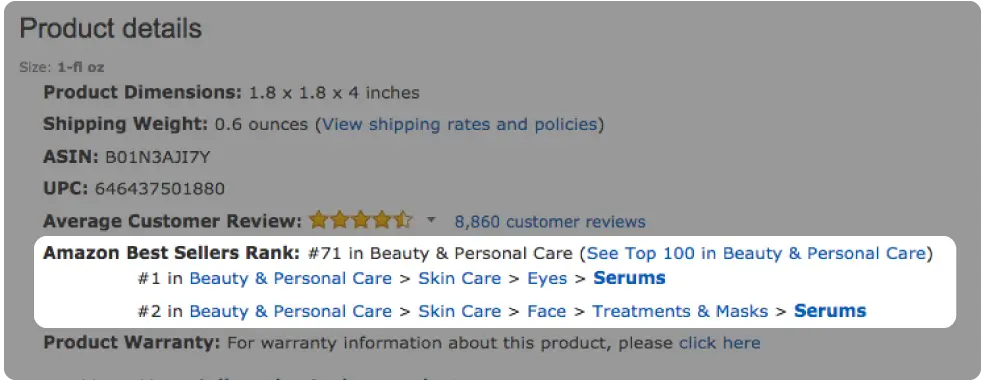
As you can see in the screenshot above, products can be listed in multiple product categories.
There is usually a top-level category: in the above example, it is #71 in Beauty & Personal Care. And there is a subcategory: this product is the #1 best seller in the subcategory, Serums. Therefore, a product can have multiple BSRs, sometimes with radical differences.
Additionally, BSR is not the same as organic sales rank on Amazon, sometimes called the Amazon sales rank. While both are tied to sales volume, they are entirely different metrics with separate meanings. Amazon best describes its connection or lack thereof below:
A top BSR will not necessarily translate into a high organic ranking, and a high organic ranking isn’t guaranteed to translate into a high BSR score. However, both ranking systems are related to sales volume. So an item that’s selling well has a better chance of ranking higher, both in organic search and on the Amazon Best Sellers Rank list.
Although BSR can be pretty complex and is often misunderstood or misinterpreted, it’s the answer to how to find best sellers rank on Amazon. It also determines who gets listed on the Amazon Best Sellers page, showcasing an Amazon top seller list of the best-selling products on Amazon and its runner-ups categorically.
How To Calculate BSR (Best Seller Rank)

Understanding how Best Sellers Rank is calculated is vital for Amazon sellers looking to maximize visibility and comprehend product rankings. Amazon’s algorithm assigns a BSR to each product based on various factors, and this metric updates hourly as products are purchased.
BSR is category-specific, meaning a product’s rank is determined within its own category or subcategory. To calculate BSR, Amazon considers the sales history of a product over time, with more recent sales carrying more weight. Essentially, the more units a product sells in a short period, the lower its BSR becomes. This highlights the importance of sales velocity – the speed at which you move products – in improving BSR.
When contextualizing BSR, you can think of it like golf: the lower the score, the better. For example, a product with a BSR of 5 is garnering significantly more sales than one with a BSR of 100 in the same category. If a product has a BSR of 100, 99 other products report a higher sales volume at that time.
Similarly, BSR only considers products within the same category when arriving at a number, so comparing the BSR of a protein powder to the BSR of a set of Bluetooth headphones means virtually nothing.
What We Found In Our Amazon BSR Study
Additionally, we’ve conducted our own studies surrounding BSR to understand better what goes into this metric. Below, we’ve included a few interesting tidbits that provide insights into how BSR is calculated:
- BSR updates for a product within 2-3 hours of a sale.
- New items with no sales do not have a BSR.
- When it comes to listing variations, some types of variations do not have their own BSR. Instead, sales roll up to the parent ASIN. Other variation types do have their own Best Sellers Rank.
- BSR is order-dependent and unit-independent. (e.g. 90 items in a single order has as much impact as an order for 1 unit).
- BSR can swing by tens, even hundreds of thousands in the lower ranks with a single sale. Likewise, BSR can plummet just as fast.
Why Best Seller Rank (BSR) Is Important For Sellers
Perhaps most importantly, BSR is often viewed as a reference point for gauging a product’s success and popularity within a category. This score can offer insight into a product’s performance, revealing whether it’s meeting its sales potential or lagging.
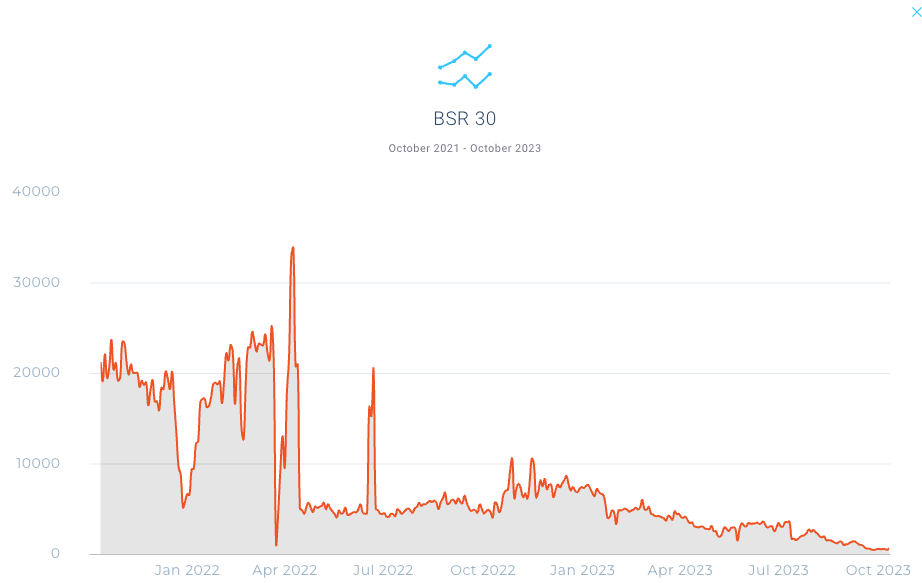
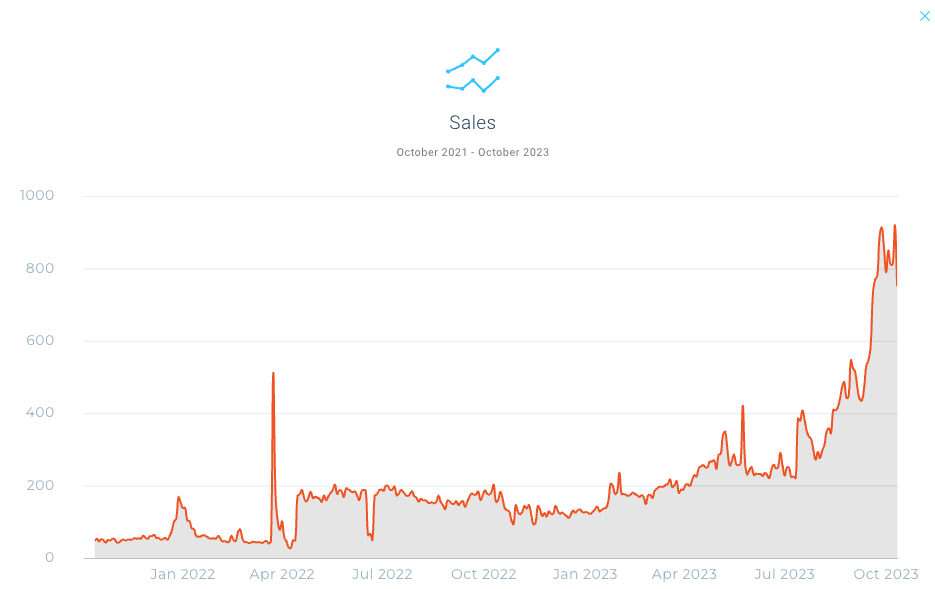
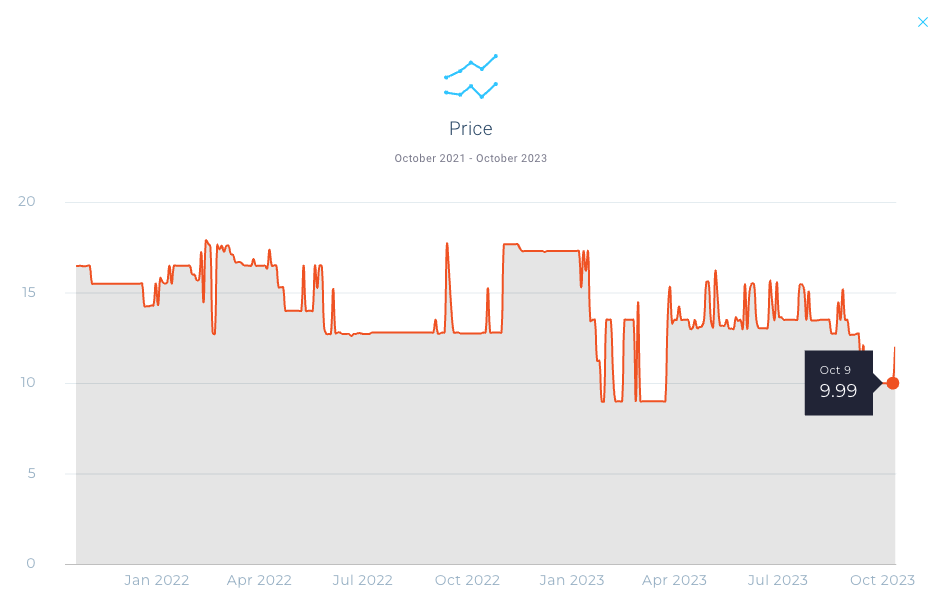
Perhaps the best example of why sellers should care about BSR, take a look at the above charts taken from Market Intelligence. The graphs illustrate BSR 30 (our metric measuring rolling BSR over 30 days), sales, and price. The BSR 30 and Sales graphs showcase an inverse relationship, which makes sense because high sales lead to a low BSR. You can also follow the performance by price and see that generally the lower the price is, the more sales and lower the BSR.
If a low (high-performing BSR) score can be maintained over time, it can lead to an increase in organic Amazon ranking. This can also drive cyclical growth, as a sustained increase in Amazon sales velocity can influence organic rank, causing a compounding effect where a wave of sales can improve your positioning for long-term success to reach your sales potential.
When you change elements of a listing, such as a price change or promotion, or updated imagery or copy, BSR’s recency bias emphasizes recent sales more than organic rank, letting you see a quicker reflection on how your updates are faring. Since BSR reflects product popularity, you can monitor it after changes to see if they work and to what extent.
Also, BSR showcases a relationship with inventory management. If a product with plenty of sales lags from an organic rank or BSR perspective, it may indicate inventory management issues. If this is the case for your product, consider your inventory management history, as it may suggest room for improvement.
4 Factors Affecting Amazon BSR
Several factors influence a product’s Amazon product ranking. Understanding and optimizing for these factors is essential for Amazon sellers aiming to improve their BSR and visibility within the marketplace. Below, we’ll introduce four crucial elements of selling on Amazon that influence BSR.
Sales History and Velocity
Sales history and velocity play a significant role in determining an Amazon product’s Best Sellers Rank. To maintain or improve BSR, sellers must focus on consistent sales, competitive pricing, effective marketing, and excellent customer service. It’s an ongoing effort that requires monitoring and adaptation to stay competitive in the Amazon marketplace.
Stock Availability
Stock availability can significantly impact a product’s BSR on Amazon. When a product is out of stock, Amazon removes it from active search results, suddenly halting sales. Because sales history and velocity are critical components driving BSR, out-of-stock items quickly tank BSR and have a lasting impact.
Seasonal Trends
Although BSR is measured compared to products within a category, seasonal highs and lows can affect it. Purely seasonal products or products with a seasonal variation may see a boost during peak-demand periods. Although the effect is small due to the rising tides of the sales seasons typically lifting all proverbial boats within a category, it can play a significant role in specific instances. Check out this podcast where we discuss everything about selling seasonal products.
Price and Promotions
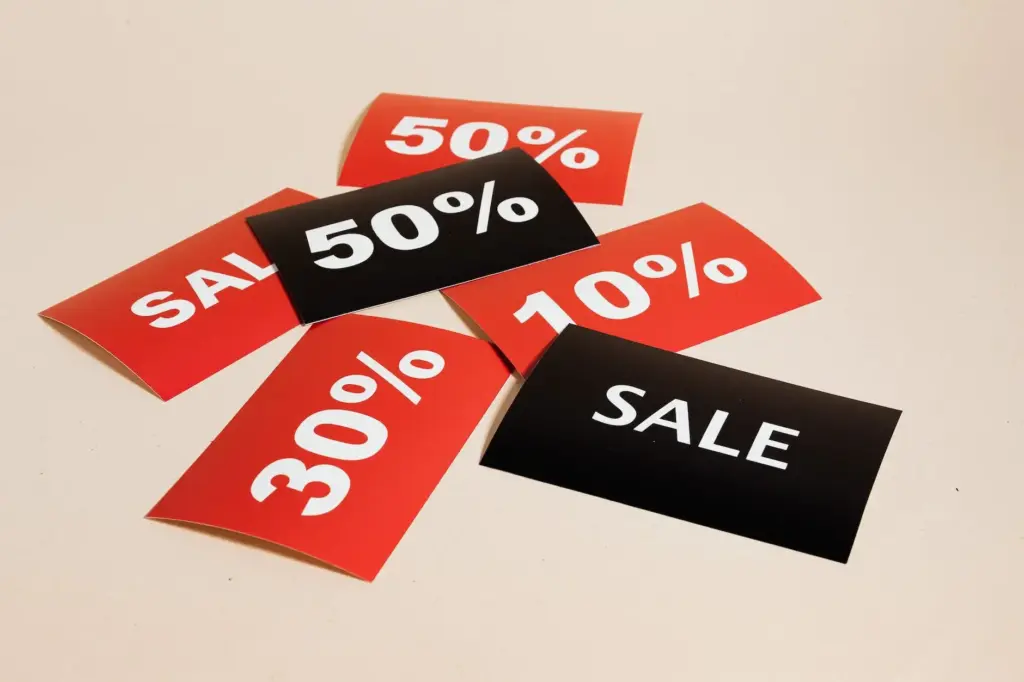
Nothing entices customers to purchase in droves quite like a good deal! While Amazon won’t change BSR solely due to price changes in either direction, the effect price will have on purchases is highly likely to influence whether or not customers purchase your product over the competition, indirectly playing a significant role in BSR.
How To Improve Amazon BSR
With these factors in mind, there are actionable steps you can take to maximize sales and improve your BSR.
Optimize Your Product Listing
Optimizing your listing is one of the most impactful ways to improve BSR. A fully optimized product listing includes maximizing relevant keywords to increase searchability and having clear, high-quality images that attract customers, inform them of your product, and give off an air of professionalism.
From a copy perspective, including relevant keywords to your product generating search volume can do wonders for visibility. When you include keywords that customers search for to find products like yours, your listing can index and rank for these terms, improving your chances of achieving organic sales through search. While including these keywords is essential, be sure to infuse them in a way that feels as organic as possible, describing the benefits of your product and answering potential questions that might lead to customers exiting your product detail page without adding to cart.
High-quality product imagery attracts clicks and informs customers about what they can expect from a product. Unlike at a local brick-and-mortar shop, customers can’t see or hold your product when shopping online. This adds importance to your product imagery, as it’s the closest substitute to physically seeing or holding a product.
Listing analyzers are available to assess the health and quality of listings and identify opportunities for improvement.
Monitor Inventory Levels
To maintain a healthy BSR and ensure consistent sales, Amazon sellers need to monitor their inventory levels closely, possess Amazon’s inventory management skills, and plan for replenishments to avoid dreaded out-of-stocks that can cause BSR to fall off a proverbial cliff.
Additionally, maintaining stock availability is critical for BSR, maximizing sales, and providing a positive customer experience. Suppose a seller can learn how to avoid out-of-stocks without accumulating unnecessary storage fees for over-allocating products in the warehouses.
Perfect Your Product Review Generation Process
Positive reviews boost buyer trust and lead to increased sales, ultimately influencing your product’s BSR. Soliciting authentic reviews, managing customer feedback, and ensuring a top-notch buying experience from discovery to utilization can play a tremendous role regarding purchases and, thus, improving BSR.
While generating authentic reviews can be incredibly difficult, our Review Automation tool gets Amazon to follow up with customers on your behalf, all within Amazon’s terms of service! Not only is Review Automation up to 5 times more effective than traditional email follow-ups, but it’s also completely safe, so you can maximize your reviews without worrying about your listing being suppressed or potentially banned, unlike many review generation “hacks” that don’t meet Amazon’s standards and leave consumers with regret.
Offer Competitive Pricing
Since sales velocity is a main ingredient in the Amazon ranking algorithm, promotional products typically see a boost in BSR. Due to this fact, keeping a watchful eye on competitors and offering enticing deals is pivotal. When a top competitor runs an effective promotion, it can siphon sales away from you. As a result, your BSR, organic rank, and bottom line become negatively impacted.
Our Competitor Intelligence tool gives you an unprecedented view of your competitors and their strategies. The reverse ASIN tool works as an Amazon rank tracker and more, keeping tabs on your fiercest competition in every meaningful way, showcasing sales and keyword performance and notifying you when others in your market make significant changes in price, reviews, sales, keyword ranking, ad placements, and more.
Sign up today to stop leaving sales to the competition and maximize your e-commerce success!
BSR Limitations
While BSR can be very helpful in estimating sales across a market, it is primarily a backward-looking metric. BSR reflects the results of a process and not the other way around. An increase in sales can lead to an improved BSR, but it certainly doesn’t guarantee future sales if other fundamental aspects of the product and its listing are not set up for success.
Due to myths and misinformation regarding BSR meaning in the industry, many sellers overemphasize BSR at a given moment. Because it can change quickly, with drastic leaps in both directions, a single look at the score lacks context that would provide it with meaning. However, tracking the score over time can be a valuable and accurate indicator of sales over time. While manually tracking BSR hourly would be a full-time job, we follow that information in Market Intelligence for you.
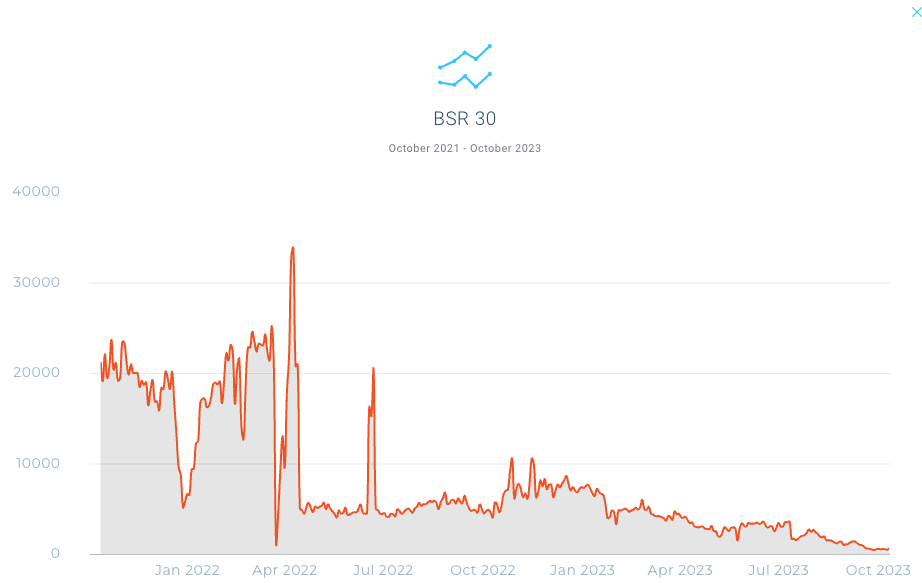
For example, look at the drastic fluctuations in springtime 2022. Can you imagine checking BSR at the highs or lows and using that data to make business decisions?
Conclusion
With so much misinformation about the Amazon Best Sellers Rank, gaining a proper understanding of this critical metric (and, just as importantly, what it isn’t) can help you gain an advantage over the competition. In the hyper-competitive Amazon landscape, every tidbit of knowledge can and should be wielded over the opposition, and any misunderstanding can lead to misplaced strategies.
As you can see, BSR indicates how well a product has sold in the past and recently. The problem is you can’t tell exactly which unless you have a detailed BSR history. Because BSR fluctuates drastically and frequently, it’s almost impossible to determine anything from a product’s BSR at a given moment.
At Viral Launch, we strongly recommend optimizing for long-term sales rather than running your business to improve BSR. With a more long-term approach, you can pursue BSR, organic rank, and a stream of profitable sales without cannibalizing one in pursuit of the others. That approach is the holy grail of selling on Amazon and a privilege the best sellers experience.
In regard to optimizing for BSR and achieving long-term success, you can trust the state-of-the-art Viral Launch software suite to inform your strategy with industry-leading data such as BSR, sales volume, keyword search volume estimates, and unparalleled competitor tracking to turn any piece of data into a competitive advantage, tipping the scales in your favor to drive sales and pace your path to entrepreneurial success.








